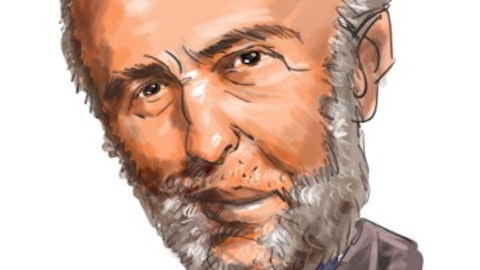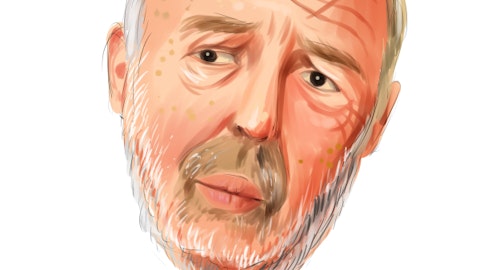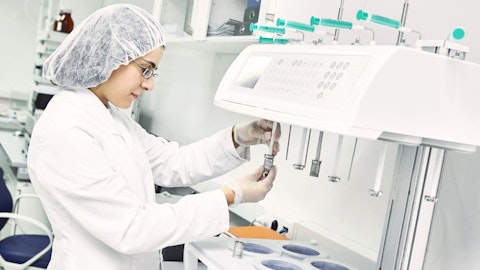Novo Nordisk A/S (NYSE:NVO) Q4 2022 Earnings Call Transcript February 1, 2023
Operator: Good day, and thank you for standing by. Welcome to the Q4 2022 Novo Nordisk A/S Earnings Conference Call. At this time, all participants are in a listen-only mode. After the speakers presentation, there will be a question-and-answer session. . Please be advised that today’s conference is being recorded. I would now like to hand the conference over to your speaker today, Lars Fruergaard Jorgensen, CEO. Please go ahead.
Lars Fruergaard Jørgensen: Thank you, operator. Welcome to this Novo’s earnings call for the full year of 2022 and the outlook for 2023. My name is Lars Fruergaard Jorgensen, and I’m the CEO of Novo Nordisk. With me today, I have Executive Vice President and Head of Commercial Strategy and Corporate Affairs, Camilla Sylvest; Executive Vice President and Head of North America Operations, Doug Langa; Executive Vice President and Head of Development, Martin Holst Lange; and finally Chief Financial Officer, Karsten Munk Knudsen. All of us will be available for the Q&A session. Today’s announcement and the slides for this call are available on our website novonordisk.com. Please note that the call is being webcast at live, and a recording will be made available on our website as well.
This call is scheduled to last one hour. Please turn to the next slide. The presentation is structured as outlined on Slide 2. Please note that all sales and operating profit, all statements will be at constant exchange rates, unless otherwise specified. Please turn to Slide 3. As always, I need to advise you that this call will contain forward-looking statements. These are subject to risk and uncertainty that could cause actual results of different materially from expectations. For further information on the risk factors, please see the company’s announcement for the full-year of 2022 and the slides prepared for this presentation. Please turn to the next slide. In 2022, we delivered double-digit sales growth and operating profit growth and we continue to make progress on our strategic aspirations.
I would like to go through the highlights before handing over the word to my colleagues. We continue to make progress across all dimensions of progress and sustainability. Our carbon emissions decreased by 29% compared to pre-pandemic levels in 2019 and we continue to reach even more patients and patients living with diabetes compared to last year. In line with our aspiration of being a sustainable employer, we expanded the number of women in leadership positions to 39% compared to 36% in 2021. Within R&D, we are pleased that we now have initiated the first two Phase 1 trials based on the siRNA interference RNA technology platform that we acquired in 2021. Looking back at 2022, we have seen exciting trial readouts across all our therapy areas and in 2023 we look forward to having an equally exciting year.
Martin will come back to this and our overall R&D milestones later. In 2022, we deliver double-digit sales growth reflecting strong commercial execution across geographies and our therapy areas by both operating units contributed to sales growth. We saw particular strong sales growth in North America driven by accelerated demand for our GLP-1 treatments for both diabetes and obesity. Camilla and Doug will go through the details per therapy area later. Karsten will go through the financials, but I’m very pleased with the sales growth of 16% and operating profit growth of 15% in 2022. Lastly, I have a brief update on our strategic aspirations within financials. We have achieved the U.S. aspiration of reverting 70% of sales to products launched since 2015, and IO sales growth has in the last couple of years surpassed expiration of 6% to 10% growth.
Consequently, we have decided to remove these regional expirations going forward will be focused on and committed to delivering solid sales and operating profit growth. With that, I’ll give the word to Camilla for an update on execution.
Camilla Sylvest: Thank you, Lars. And please turn to the next slide. As Lars mentioned, our 16% sales growth for the full-year of 2022 was driven by both operating units with North America operations growing by 21% and international operations growing 13%. The strong sales growth has unfortunately resulted in periodic supply constraints and related drug shortage notifications across a number of products and geographies. Our GLP-1 sales increased by 42%, driven by North America growing 36% and international operations growing 57%. Insulin sales decreased by 11%, driven by a 7% decline in international operations and a 21% sales decline in North America operations. The U.S. insulin sales declined by 22%. This was driven by lower realized prices as well as a decline in volume.
Compared to 2021, the U.S. insulin volume market declined by 3%. Furthermore, insulin sales in international operations were impacted by the implementation of volume-based procurement in China, starting in May 2022 and lower sales in EMEA. Obesity care sales grew by 84% overall and international operations sales grew by 82% and in North America operations obesity care sales grew 85%. In the U.S. obesity care sales grew by 90%. Rare disease sales grew 1% driven by 5% sales increase in international operations offset by a 5% decline in North America operations. Please turn to Slide 6. Our 14% sales growth within diabetes care continues to been higher than the overall diabetes market. That means we have improved our market share by 1.8 percentage points to 31.9%.
We continue to be on track to reach one-third of the diabetes value market by 2025. This increase primarily reflects GLP-1 market growth as well as share gains in both operating units. Please turn to the next slide. International operations diabetes care sales increased by 10% in 2022, driven by GLP-1 sales growing by 57%. Novo Nordisk remains the market leader in international operations with a GLP-1 value market share of 64%. This is driven by share gains across geographies. Ozempic continues to expand its GLP-1 market share leadership in international operations with around 43% market share. While the GLP-1 class growth is more than 50%, GLP-1 penetration remains low at around 5% of total diabetes groups globally. Rybelsus sales more than doubled compared to 2021.
The growth was mainly driven by new launches and increasing volumes, making Rybelsus the second largest growth contributor in 2022 after Ozempic. The increased momentum in international operation is driven by launches in key markets such as Japan, Italy and Spain. And with that, I will hand over the word to Doug.
Doug Langa: Thank you for that update, Camilla. Please turn to the next slide. The U.S. GLP-1 market volume grew by around 50%, comparing the fourth quarter of 2022 to the fourth quarter of 2021. The recent competitor launch in GLP-1 has supported the continued acceleration in market growth and from an NBRx perspective, we continue to see all-time high levels of new patients starting on our portfolio of GLP-1 products on the end of 2022. Measured on total prescriptions, Novo Nordisk has maintained its market share leadership with a market share of more than 50%. Please go to the next slide. Obesity care sales increased by 84% with 85% growth in North America operations and 82% in international operations. The global branded obesity market expansion continues with a volume growth of more than 50%.
We are excited that Wegovy is now launched in Denmark and Norway, their first two markets outside of the U.S. But we also remain encouraged by the performance of Saxenda in international operations. Region EMEA is the key growth driver with 96% growth in 2022. In the U.S., obesity care sales grew 90% with both Wegovy and Saxenda contributing to growth. All dose strengths of Wegovy were made available in the U.S. again in December of 2022. And in only a few weeks, Wegovy prescription trends have accelerated and already reached all-time high levels. The uptake underlines the significant unmet need for patients with obesity. Many patients have been waiting for all doses of Wegovy to be available again, which has created a pent-up demand. We are now looking forward to continuing the relaunch of Wegovy.
Now back to Camilla for an update on rare disease.
Camilla Sylvest: Thank you, Doug. And next slide, please. Our rare disease sales increased by 1% in 2022. This was driven by a 5% sales growth in international operations offset by a 5% decline in North America provisions, where blood disorders grew by 7% driven by NovoSeven as well as the launch products Esperoct and Refixia. Specifically, Haemophilia A products grew by 6%, Haemophilia B sales by 16% and NovoSeven by 6%. Rare endocrine disorder sales declined by 6%. The declining sales were driven by international operations decreasing 1% and by North America operations decreasing by 18%. The sales were negatively impacted by lower realized prices in the U.S. as well as the supply constraint in the fourth quarter of 2022. And now over to you, Martin, for an update on R&D.
Martin Holst Lange: Thank you, Camilla. Please turn to Slide 11. Firstly, I’m very happy to be able to share that we have initiated two Phase 1 trials within NASH. This is particularly exciting because the two assets are both based on the small interfering RNA technology that we acquired as part of the Dicerna acquisition back in 2021. Both trials are 52-week trials and target LXR and MARC1, respectively. Both assets are aiming for long-term NASH resolution and fibrosis improvement with monthly or even less frequent dosing. The objective of both Phase 1 trials is to investigate the safety, tolerability and PK/PD profile of each asset respectively. The fact that we have now initiated these trials is a testimony to the successful integration and fast progression of the RNA-based research and development in Novo Nordisk.
As mentioned at our Capital Markets Day in March of last year, our ambition is to generate an annual average of free first human doses across therapy areas based on the RNA technology over the next 10 years. Please turn to the next slide. We’re looking forward to a very exciting 2023 with many important Phase 3 trial readouts across our therapy areas. I would like to briefly go through a few highlights. Within Type 2 diabetes, we expect to see results from the Phase 3 trial PIONEER PLUS with once-daily oral semaglutide 25 and 50 milligram, respectively, during the first half of 2023. The primary endpoint of the 68-week trial is to confirm superiority of oral semaglutide 25 and 50-milligram versus oral semaglutide 14-milligram on A1C reduction.
The expectation is to reach an efficacy and safety profile comparable to that of Ozempic. Also in diabetes, we expect to initiate the Phase 3 program with CagriSema in the second half of 2023, following the very exciting Phase 2 results that we shared last year. Furthermore, we have completed the 26-week safety extension phases for the ONWARDS 1 and 6 trials with insulin icodec. The results confirm that insulin icodec has the potential to be the ideal starter insulin for people with Type 2 diabetes, while there are still more assessments to be done in Type 1 diabetes. We expect to submit insulin icodec for regulatory review in the first half of 2023. In obesity, we look forward to sharing the Phase 3 results from once daily oral semaglutide 50 milligram, where our expectation is to reach a level of efficacy and safety comparable to that.
Pending the results, this would add to our portfolio of obesity treatments to address the significant unmet need that remains for many patients with obesity. Furthermore, we look forward to sharing the results from the ongoing SELECT Cardiovascular Outcomes Trial in the middle of 2023. Within rare disease, we are looking forward to a decision from regulatory authorities on once-weekly Sogroya for the treatment of growth hormone deficiency. This will offer a reduced treatment burden compared to daily Norditropin and a device that is easy to use for patients. Finally, we expect to initiate a Phase 3b trial with Ziltivekimab for the treatment of heart failure with preserved ejection fraction in the first half of 2023. Altogether, we’re looking forward to a very exciting year with clinical trial initiations as well as results across all therapy areas.
With that, over to you, Karsten.
Karsten Munk Knudsen: Thank you, Martin. Please turn to the next slide. In 2022, our sales grew by 26% in Danish kroner and 16% at constant exchange rates, driven by both operating units. The gross margin increased to 83.9% compared to 83.2% in 2021, driven by a positive product mix due to increased GLP-1 sales, a positive currency impact and productivity improvements. Lower realized prices, particularly in the U.S. and China partially offset these effects. Sales and distribution costs increased by 25% in Danish kroner and 16% at constant exchange rates. The increase is driven by launch activities and promotional spend for Rybelsus and Ozempic as well as market development activities for obesity. The cost increase is reflecting low activity levels in 2021 due to COVID-19 and higher distribution costs.
Research and development costs increased by 35% in Danish kroner and 29% at constant exchange rates. The increase is driven by higher clinical activity levels within other serious growing diseases and GLP-1 as well as the operating costs and amortizations related to the acquisition of Dicerna Pharmaceuticals. We acquired Dicerna in the fourth quarter of ’21. Administration costs increased by 10% in Danish kroner and 6% at constant exchange rates. Operating profit increased by 28% in Danish kroner and by 15% at constant exchange rates. Net financial items for 2022 showed a loss of around DKK 6 billion compared to a gain of around DKK 0.4 billion in ’21. This mainly relates to losses following the appreciation of the U.S. dollar as reflected in the favorable currency impact on operating profits.
As per the end of December ’22, a positive market value of financial contracts of approximately DKK 1 billion has been deferred for recognition in 2023. The effective tax rate in ’22 was 19.6% compared to 19.2% in ’21, mainly reflecting nonrecurring impacts from acquisitions. Net profit increased by 16% and diluted earnings per share increased by 18% to DKK 24.44. Free cash flow was DKK 57.4 billion compared to DKK 29.3 billion in ’21, supporting the strategic aspiration to deliver attractive capital allocation to shareholders. The cash conversion in ’22 is positively impacted by timing of rebate payments in the U.S., including provisions related to the revised 340B distribution policy in the U.S. Income under the 340B program has been partially recognized.

Copyright: nexusplexus / 123RF Stock Photo
Please go to the next slide. In 2023, we expect to increase our capital expenditure to around DKK 25 billion. This is a significant step-up compared to 2022 and reflects the innovation-based growth strategy that we’re pursuing in Novo Nordisk. The increase in capital expenditure mainly relates to investments in additional capacity for active pharmaceutical ingredient production and fill/finish capacity for both current and future injectable and all products across therapy areas. In the coming years, the capital expenditure to sales ratio is expected to be low double-digits. The investments will gradually add capacity, flexibility and resilience in our manufacturing setup while also accommodating for potential upsides to forecast. Next slide, please.
In 2022, we returned more than DKK 49 billion to shareholders via dividends and share buybacks. Novo Nordisk has consistently returned its free cash flow to investors through both share buybacks and dividends. At the Annual General Meeting on March 23, 2023, the Board of Directors will propose a final dividend of DKK 8.15 for a total 2022 dividend of DKK 12.40, a 19% increase compared to 2021, making it the 27th consecutive year with increasing dividends. In addition to the dividend, DKK 24 billion was used for repurchase of shares. For 2023, the Board of Directors has approved a new share repurchase program of up to DKK 28 billion to be executed during the coming 12 months. Next slide, please. We continued 2023 with solid growth momentum and expect the sales growth to be between 13% and 19% at constant exchange rates.
This is based on several assumptions as described in the company announcement. The guidance reflects expectations for sales growth in both International Operations and North America operations, mainly driven by GLP-1 based treatments for diabetes and obesity care. The sales growth within diabetes and obesity care is expected to be partially countered by declining sales in rare disease due to supply constraints. The guidance ranges for sales and operating profit growth reflect the level of volume growth of GLP-1-based diabetes treatments. They also reflect the inherent uncertainty of the pace of obesity care market expansion following the relaunch of Wegovy in the U.S. and expected gradual rollout in international operations. The outlook includes an expectation of continued periodic supply constraints and related drug shortage notifications in 2023 across a number of products and geographies.
This is driven by higher-than-expected volume growth for GLP-1 based products, such as Ozempic and temporary capacity limitations at some manufacturing sites. We’re gradually increasing our supply capacity. We expect that operating profit will grow between 13% and 19% at constant exchange rates. This primarily reflects the sales growth outlook and continued investments in current and future growth drivers within research, development and commercial. Commercial investments are mainly related to the relaunch of Wegovy in the U.S., obesity care market development activities in international operations as well as promotional activities for Ozempic and Rybelsus. The acquisition of Forma Therapeutics is negatively impacting operating profit growth due to higher operating costs and amortizations.
Finally, the guidance also reflects inflationary impacts on the cost base. Given the current exchange rates, most notably a weakening of the U.S. dollar, we expect a negative currency impact for 2023. Our reported sales are expected to be four percentage points lower at CER and operating profit is expected to be five percentage points lower at CER. The negative currency impact on operating profit of five percentage points is partially offset by a net gain on financial items. We expect that financial items will amount to a net gain of around DKK 2.4 billion, mainly reflecting gains associated with foreign exchange and hedging contracts. Capital expenditure is expected to be around DKK 25 billion in 2023, as I outlined earlier in this presentation.
Our free cash flow is now expected to be between DKK 60 million and DKK 68 billion, reflecting the sales growth and investments in capital expenditure. That covers the updated outlook for ’23. Now back to you, Lars, for final remarks.
Lars Fruergaard Jørgensen: Thank you, Karsten. Please turn to the final slide. We’re very pleased with double-digit sales growth for the full-year of 2022 and that we continue to reach even more patients. 2023 is a truly significant year in history of Novo Nordisk as we celebrate our 100-year anniversary. In this period, we have grown from a small Danish company into a global one, developing life-saving medicines for millions of patients around the world. In 2023, we look forward to continuing our focus on commercial execution, expanding our pipeline and investing significantly in the expansion of production capacity for current and future products. With that we’re now ready for the Q&A, where kindly ask all participants to limit her or himself one or maximum two questions. Operator, we’re now ready to take the first question.
See also 10 Recent Spinoff Companies Hedge Funds Are Buying and Dividend Kings and Artistocrats List.
Q&A Session
Follow Novo Nordisk A S (NYSE:NVO)
Follow Novo Nordisk A S (NYSE:NVO)
Operator: Thank you. . We will now take our first question. One moment, please. And it comes from the line of Harry Sephton from Credit Suisse. Please go ahead. Your line is open.
Harry Sephton: Thank you very much for taking my question. I’ll just the one on pricing, please. So our latest pricing data suggests that you’ve only taken a low single-digit price increase in January across your U.S. portfolio, despite the larger headroom for price increases this year with high CPI. Could you look to increase prices the second time later in the year given the headroom for price increases? And then just on your international operations as well. There are a number of drug pricing reforms being proposed across European markets. Do you anticipate that these changes could be material near-term headwinds to your growth in international operations? Thank you very much.
Lars Fruergaard Jørgensen: Thank you, Harry. So Doug, a perspective on how we look at pricing in the U.S. first.
Doug Langa: Yes. Thanks, Harry, for the question. We had a commitment back in 2016 around price and we’ve held that commitment. And I don’t want to give any forward-looking statements on price moving forward.
Lars Fruergaard Jørgensen: Thank you. So on Europe, we don’t anticipate any single event to be material. We have over the years seen various countries operating with the different reforms sometimes in the form of something that looks more like a tax. So we used to operating in this environment, and you should expect that for now, our guidance incorporates what we anticipate in this. Thank you, Harry. So next question, please.
Operator: Thank you. We will now take the next question. And it comes from the line of Peter Verdult from Citi. Please go ahead. Your line is open.
Peter Verdult: Thank you. Pete Verdult from Citi. Two questions, Doug and Camilla. Firstly, just in light of these U.S. GLP-1 trends we’re seeing, the intense publicity and media coverage. Can you characterize how if at all recent payer discussions are evolving? Are you sensing any efforts to step up and restrict access more aggressively? And can you provide an update on the DKK 30 million commercial opt-in number that you provided at Q3? And then to Lars and Karsten, just if I could try my luck and push you to better understand what is possible and what is not with respect to Wegovy capacities that you have in place for 2023. If I look at the Q1 trends, we’re fast approaching 40,000 weekly script rate, which is implying annualized sales around DKK 3 billion.
I know you’ve talked about pent-up demand, but you and Lilly are also going to start promoting quite actively to develop the market further. So just with that in mind, do you have the theoretical capacity in place to support Wegovy being a DKK 3 billion to DKK 4 billion drug in 2023? I’m not asking for guidance, but I want to get a handle on what’s possible and what is in respect to market potential this year? Thank you.
Lars Fruergaard Jørgensen: Thank you, Pete. So Doug, first, on U.S. GLP-1 trends peer discussions and the patient access we have.
Doug Langa: Yes. Thanks, Pete, for the question. And I would say that certainly, first thing to recognize is that the volume of prescriptions in the GLP-1 category is still only about 10%. So there’s a lot of runway there. Secondly, what I would say is that the payers do tech notice the categories that are growing. This one is certainly growing at double-digit, but they also recognize the need for this product. And again, it’s only 12% — 10% of the subscription volume. Did I miss something within there?
Lars Fruergaard Jørgensen: There so.
Peter Verdult: DKK 30 million.
Doug Langa: Yes, Pete, I’m sorry. Importantly, we guided on — in Q3 of DKK 30 million. We’re now at approximately 40 million lives. So it’s overall 80% access, and that equates to the effective access or number of lives is approximately 40 million. And that’s comprised of commercial, Medicaid and some federal business.
Lars Fruergaard Jørgensen: Thank you, Doug. And Karsten, on Wegovy capacity versus what we see in the market now. I know you’re not going to tell the whole story. What can you say?
Karsten Munk Knudsen: Yes. So it’s, of course, a key question that we spend a lot of time on, also internally to ensure that we’re not disappointing our customers when we launch products in different markets. And my starting point to answering the question is the guidance I just covered before. So at 13% to 19% top-line growth guidance, which in itself is very competitive industry-wise, is of course, very attractive and a large chunk of that growth comes from Wegovy. So we will not be able to get to this level of guidance without a significant step-up in Wegovy. And as I’m sure you can appreciate, then it’s important for us to say that we can supply to our guidance. So both the top end and the low end of the guidance. So that’s what we commit to in terms of our investor communication.
Then in terms of additional scenarios, then what I would say is that the — that 19% is not a magic ceiling in terms of our guidance. It’s basically a function of products and geographies and timing. And then yes, we continue to scale our manufacturing capacity of Wegovy. As you know, we have one line in-house. We have one CMO up and running full speed and we have one line on track to be online in first half of this year. And then another line on track to be — get online second half this year. So we have significant step-up in Wegovy production capacity. And then I’d say, just at a final note, of course, we have — we do not have unlimited capacity. And so trending on a vertical TRx uptake is impossible. And that’s why we’ve been out saying be careful with the first data points because they are impacted by the pent-up demand that Doug was talking to.
Lars Fruergaard Jørgensen: Thanks, Karsten.
Karsten Munk Knudsen: Thank you.
Lars Fruergaard Jørgensen: So to summarize, clearly, a significant addressable market from an access point of view and also capacity coming in, so we can go after that opportunity. So very encouraging, indeed. Thank you, Pete. Next question, please.
Peter Verdult: Thank you.
Operator: Thank you. We will now take the next question. And it comes from the line of Michael Nedelcovych from Cowen. Please go ahead. Your line is open.
Michael Nedelcovych: Thank you for the questions. I have two. The first is on the SELECT trial. When taking interim looks at SELECT, does Novo consider whether or not a futility analysis has been prespecified and presumably passed to be material information to be shared with the market? That’s the first question. And then the second question is on the oral semaglutide readout. So when we see Phase 3 obesity data for oral semaglutide, some of our consultants are expecting meaningfully diminished weight loss relative to injectables. If that ends up being the case, what percent weight loss would still support commercial success? Thank you.
Lars Fruergaard Jørgensen: Thank you, Michael. I think Martin those are upwards to you.





